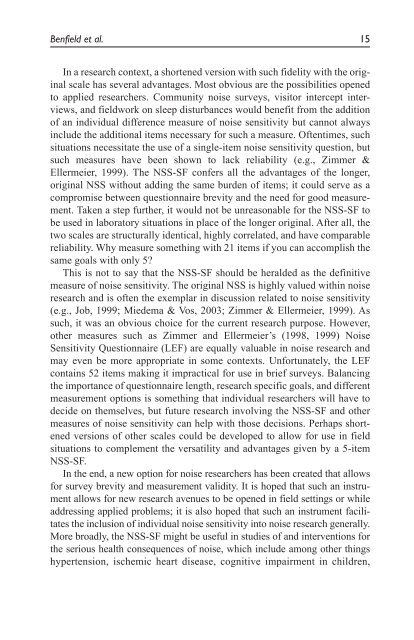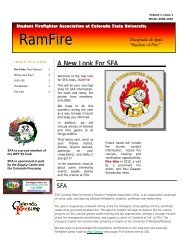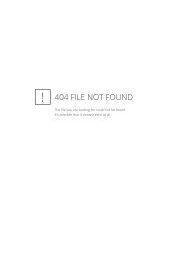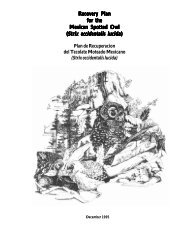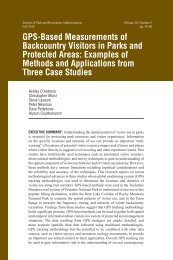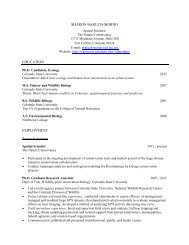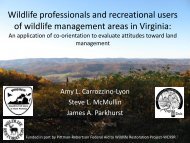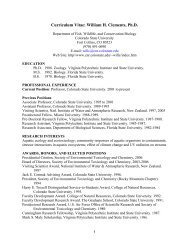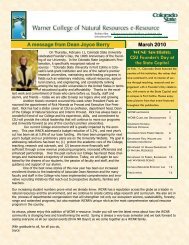Benfield, J.A., Nurse, G.A., Jakubowski, R., Gibson, A., Taff, D ...
Benfield, J.A., Nurse, G.A., Jakubowski, R., Gibson, A., Taff, D ...
Benfield, J.A., Nurse, G.A., Jakubowski, R., Gibson, A., Taff, D ...
You also want an ePaper? Increase the reach of your titles
YUMPU automatically turns print PDFs into web optimized ePapers that Google loves.
<strong>Benfield</strong> et al. 15<br />
In a research context, a shortened version with such fidelity with the original<br />
scale has several advantages. Most obvious are the possibilities opened<br />
to applied researchers. Community noise surveys, visitor intercept interviews,<br />
and fieldwork on sleep disturbances would benefit from the addition<br />
of an individual difference measure of noise sensitivity but cannot always<br />
include the additional items necessary for such a measure. Oftentimes, such<br />
situations necessitate the use of a single-item noise sensitivity question, but<br />
such measures have been shown to lack reliability (e.g., Zimmer &<br />
Ellermeier, 1999). The NSS-SF confers all the advantages of the longer,<br />
original NSS without adding the same burden of items; it could serve as a<br />
compromise between questionnaire brevity and the need for good measurement.<br />
Taken a step further, it would not be unreasonable for the NSS-SF to<br />
be used in laboratory situations in place of the longer original. After all, the<br />
two scales are structurally identical, highly correlated, and have comparable<br />
reliability. Why measure something with 21 items if you can accomplish the<br />
same goals with only 5?<br />
This is not to say that the NSS-SF should be heralded as the definitive<br />
measure of noise sensitivity. The original NSS is highly valued within noise<br />
research and is often the exemplar in discussion related to noise sensitivity<br />
(e.g., Job, 1999; Miedema & Vos, 2003; Zimmer & Ellermeier, 1999). As<br />
such, it was an obvious choice for the current research purpose. However,<br />
other measures such as Zimmer and Ellermeier’s (1998, 1999) Noise<br />
Sensitivity Questionnaire (LEF) are equally valuable in noise research and<br />
may even be more appropriate in some contexts. Unfortunately, the LEF<br />
contains 52 items making it impractical for use in brief surveys. Balancing<br />
the importance of questionnaire length, research specific goals, and different<br />
measurement options is something that individual researchers will have to<br />
decide on themselves, but future research involving the NSS-SF and other<br />
measures of noise sensitivity can help with those decisions. Perhaps shortened<br />
versions of other scales could be developed to allow for use in field<br />
situations to complement the versatility and advantages given by a 5-item<br />
NSS-SF.<br />
In the end, a new option for noise researchers has been created that allows<br />
for survey brevity and measurement validity. It is hoped that such an instrument<br />
allows for new research avenues to be opened in field settings or while<br />
addressing applied problems; it is also hoped that such an instrument facilitates<br />
the inclusion of individual noise sensitivity into noise research generally.<br />
More broadly, the NSS-SF might be useful in studies of and interventions for<br />
the serious health consequences of noise, which include among other things<br />
hypertension, ischemic heart disease, cognitive impairment in children,


